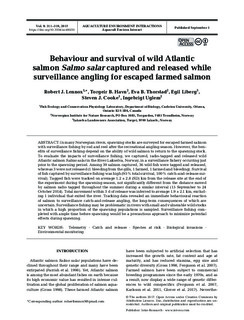| dc.contributor.author | Lennox, Robert J. | |
| dc.contributor.author | Havn, Torgeir Børresen | |
| dc.contributor.author | Thorstad, Eva Bonsak | |
| dc.contributor.author | Liberg, Egil | |
| dc.contributor.author | Cooke, Steven J. | |
| dc.contributor.author | Uglem, Ingebrigt | |
| dc.coverage.spatial | Lakselv, Porsanger, Finnmark, Norge, Norway | nb_NO |
| dc.date.accessioned | 2017-09-29T10:22:02Z | |
| dc.date.available | 2017-09-29T10:22:02Z | |
| dc.date.created | 2017-09-08T09:15:35Z | |
| dc.date.issued | 2017 | |
| dc.identifier.citation | Aquaculture Environment Interactions. 2017, 9 311-319. | nb_NO |
| dc.identifier.issn | 1869-215X | |
| dc.identifier.uri | http://hdl.handle.net/11250/2457473 | |
| dc.description.abstract | In many Norwegian rivers, spawning stocks are surveyed for escaped farmed salmon with surveillance fishing by rod and reel after the recreational angling season. However, the benefits of surveillance fishing depend on the ability of wild salmon to return to the spawning stock. To evaluate the impacts of surveillance fishing, we captured, radio-tagged and released wild Atlantic salmon Salmo salar in the River Lakselva, Norway, in a surveillance fishery occurring just prior to the spawning period. Among 39 salmon captured, 36 wild fish were tagged and released, whereas 3 were not released (1 bleeding from the gills, 1 farmed, 1 farmed and bleeding). Survival of fish captured by surveillance fishing was high (95% total survival, 100% catch-and-release survival). Tagged fish were tracked on average 1.2 ± 2.8 (SD) km from the release site at the end of the experiment during the spawning season, not significantly different from the distance moved by salmon radio tagged throughout the summer during a similar interval (15 September to 24 October 2014). Total movement within 3 d of release was inferred to average 1.9 ± 2.1 km, excluding 1 individual that exited the river. Tracking data revealed an immediate behavioural reaction of salmon to surveillance catch-and-release angling, the long-term consequences of which are uncertain. Surveillance fishing may be problematic in rivers with small and vulnerable wild stocks in which a high proportion of the spawning populations is sampled. Surveillance fishing completed with ample time before spawning would be a precautious approach to minimize potential effects during spawning. Telemetry · Catch and release · Species at risk · Biological invasions · Environmental monitoring | nb_NO |
| dc.language.iso | eng | nb_NO |
| dc.rights | Navngivelse 4.0 Internasjonal | * |
| dc.rights.uri | http://creativecommons.org/licenses/by/4.0/deed.no | * |
| dc.title | Behaviour and survival of wild Atlantic salmon Salmo salar captured and released while surveillance angling for escaped farmed salmon | nb_NO |
| dc.type | Journal article | nb_NO |
| dc.type | Peer reviewed | nb_NO |
| dc.description.version | publishedVersion | nb_NO |
| dc.subject.nsi | VDP::Zoologiske og botaniske fag: 480 | nb_NO |
| dc.subject.nsi | VDP::Zoology and botany: 480 | nb_NO |
| dc.source.pagenumber | 311-319 | nb_NO |
| dc.source.volume | 9 | nb_NO |
| dc.source.journal | Aquaculture Environment Interactions | nb_NO |
| dc.identifier.doi | 10.3354/aei00235 | |
| dc.identifier.cristin | 1491972 | |
| dc.relation.project | Andre: Natural Sciences and Engineering Research Council of Canada | nb_NO |
| dc.relation.project | Andre: Fiskeridirektoratet | nb_NO |
| dc.relation.project | Andre: Miljødirektoratet | nb_NO |
| cristin.unitcode | 7511,3,0,0 | |
| cristin.unitname | Avdeling for akvatisk økologi | |
| cristin.ispublished | true | |
| cristin.fulltext | original | |
| cristin.qualitycode | 1 | |

